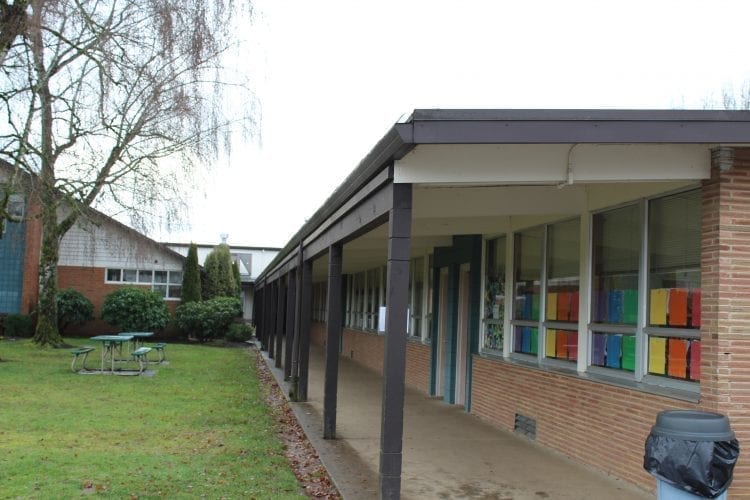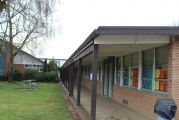District will run bond vote on Apr. 24
BATTLE GROUND — Members of the Battle Ground Public Schools’ Board of Directors voted at a special meeting Wednesday evening to place a bond on a special election ballot that will be held on Apr. 24, 2018.
The meeting came after a previous bond vote failed to pass on Feb. 13. Superintendent Mark Ross presented the resolution proposal at Wednesday’s meeting. Ross said that a bond can be run two times in a calendar year, and the next two opportunities were in April and again on Aug. 7.
Ross said that while the final tally of votes had yet to be certified, 58.67 percent of those that cast ballots voted in favor of the bond, and that the bond failed by approximately 220 votes. It needed a 60 percent majority to pass.

The ideal situation would be to run the bond again on Apr. 24, Ross said. He said that growth in the district means that current campuses such as Glenwood Heights Primary School and Laurin Middle School, two projects on the bond, are facing growth that will outstrip the ability of the facilities to house the students if new buildings are not constructed.
Ross also explained that Glenwood Heights, Laurin and Pleasant Valley Primary and Middle School are built to an old “California design,” that features classrooms that almost all have their own external doorway. This design is not up to current safety and security standards, Ross explained. He also said that simple renovations of those schools are “not going to change the design of those schools.”
Battle Ground Public Schools seek capital bond

According to Ross, running the bond on Apr. 24 will ride “pretty good momentum” from the effort to pass the bond in February. He also said that running the bond as soon as possible would be “prudent” to take advantage of interest rates and construction costs before those rise. He also said that under current projections, the tax rate if the bond is approved is “projected to actually decrease even with the bond passing.”
Two resolution options were presented to the school board. Option 1 was to place the bond on the ballot unaltered from its iteration in February. This would provide for replacing Glenwood Heights, Laurin and Pleasant Valley schools, replacing some structures at Prairie High School, renovation of a building and the gymnasium at Amboy Middle School, constructing an Alternative Learning Experience campus, and building a new primary and middle school, as well as improving school infrastructure, technology, safety and security. The total cost of bond option 1 is $224,895,000.
The second option did not change the project list. However, it was $9 million less because it proposed utilizing school impact fees from new development in the district to build modular buildings which will make up part of the Alternative Learning Experience campus and Prairie High School development. Ross said that Option 2 was not initially proposed because of concerns that the district’s impact fees would not have been sufficient to cover the costs.
The board members raised some questions about the new bond proposal, as well as some concerns from voters from the last bond. Ross addressed questions about the CAM Academy campus, which the proposal to move to an Alternative Learning Experience site had raised concerns from CAM Academy families during the first bond process.
Ross said that some of the concerns from the families was that the new space would not be equivalent to the old. He said that impact fees could to some extent be used to address that. Also, Ross noted that there had been concerns raised about the location of the new facility, and that in the new bond resolution the Alternative Learning Experience campus was not given a set location, rather the option was left open to determine what district owned land the facility would be built on.
School board member Mavis Nickels asked if considerations had been made to prepare for the possibility of a second bond failure. Ross said that there will be a discussion about the consequences and ways to move forward in March, and that while discussions have happened, nothing has yet been planned.
“We need to be prepared for that,” Ross said.
Board member Tina Lambert asked what it would take to get the approximately 220 no votes to become yes votes. Board president Ken Root said that voters need to be reminded to turn in their ballots, and that he hoped voters would see the intent behind the bond.
“As transparent as we can be, hopefully people will understand the long-term approach,” Root said, as opposed to a short-term solution.
Board member Monty Anderson said that moving forward with a bond was necessary, and noted that it was important that the proposal provide for what is needed, and “not ask for anything more, and not ask for anything less.”
Ross said that the current proposal is designed to address needs related to projected growth, and that it is not just a matter of the district wanting to provide things that are good but not necessary.
During open public comment, Dick Rylander was the only citizen to testify against placing the bond on a special ballot in April. He said that there really was little difference between the two bond options, and that Option 2 should be a “notably reduced amount.” He also proposed running the bond in August instead of April, as there may be a lower voter turnout, which would mean that fewer voters may vote against it, and thus provide the majority needed to pass the bond.
Rylander also said that with county property taxes increasing, running the bond in April would come at an “unsettling time.”
Several citizens stepped forward to express support for the bond.
Cathy Golik, a member of the group Citizens for Better Schools and member of the district’s Facilities Improvement Team, said that passing the bond was extremely important. In the board’s discussion, board member Troy McCoy raised the question of promising a potential rebate to taxpayers after the bond was passed if it could be budgeted. Golik said that doing so was not a good idea, as surplus funds could be used elsewhere in the district. “You never know what is coming,” Golik said, and therefore urged that potential rebates on the bond not be a selling point to voters.
Should a rebate be promised, and then those funds used for needed projects that come up in the future, “in some voters’ perceptions, that means that the board lied to them,” Golik said.
Dave Halme said that while there will always be people who will vote no on a bond measure, the thrust should be getting more people to turn out to vote. He said that he was encouraged by the fact that many people simply forgot to vote, and that those could be the key to approving the bond. “It’s in the best interest of taxpayers,” Halme said.
Peter Van Nortwick, county assessor and a father in the Battle Ground School District, said that he supported the bond, but wanted to see a vision of what the new schools would look like. “I want a vision, what will it look like?” He thought that the district might have a better chance of passing the bond if voters could visualize what they were voting on.
Sue Cranke, a member of the Facilities Improvement Team, said that the proposed bond made the most sense given the district’s current situation. She said that she did not “want to see the plan decrease by any amount.”
Kerri Upton, a teacher at Glenwood Heights and parent of a child in the district, said that she supported the idea that it was best to run the bond again in April, to take advantage of the momentum from the February bond campaign. “We owe this to our community, our families, our students,” Upton said.
After the public testimony, the board members voted on the bond proposal. The board voted 4 to 1 to approve Option 1 to be placed on a special election ballot on Apr. 24. McCoy was the only no vote.
The board members also appointed committee members to write the pro and con statements for the bond. Beth Goble, Curtis Miller and Dave Halme all applied and were appointed to the pro statement committee. The board had not received any applicants for the con statement, but Rylander volunteered at the meeting and was approved.




